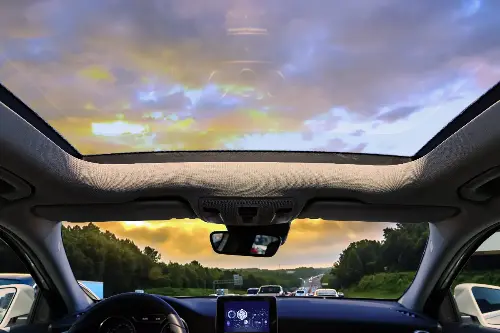The charm of a sunroof is undeniable – the open sky, the fresh air, and the illusion of a convertible without the hefty price tag. Many drivers are drawn to the sophisticated look and the freedom it seemingly offers. However, having that pane of glass overhead might not be as beneficial as it first appears. Let’s delve into the less talked about aspects of owning a car with a sunroof.

The Sunroof Weight Debate
One of the most overlooked aspects of sunroof-equipped cars is the added weight. While this might not seem like a major concern, consider that the additional weight is at the top of the vehicle. This can affect the centre of gravity, potentially altering the car's handling and stability. In performance terms, it's typically better to reduce weight from the top of the vehicle than to add to it. A heavier car will also generally use more fuel, which can be a downside for both your wallet and the environment.
Increased Risk of Leaks and Breakage
Sunroofs add complex mechanisms to what is usually a simple metal roof. Moving parts mean wear and tear and the potential for mechanical failures, including stuck or leaking sunroofs. Water leaks can lead to unpleasant smells, damp upholstery and even electrical problems if the water seeps into the cabin. On the other hand, glass sunroofs can also shatter. Although it's not a common occurrence, when it does happen it can be dangerous and costly to repair.

Impact on Fuel Efficiency
Although it might seem counterintuitive, riding with the sunroof open can reduce fuel efficiency. The reason? Aerodynamics. An open sunroof disrupts the airflow over the vehicle, increasing drag and forcing your car to work harder, burning more fuel in the process. Driving at high speeds with an open sunroof might feel great, but it could be contributing to more trips to the fuel pump.
Noise Factor
Sunroofs can also introduce additional noise into your driving experience. Even when closed, the extra seals required for a sunroof can sometimes let in more road noise compared to a traditional roof. When open, the wind noise can be even louder, often requiring drivers to raise their voice for conversations or turn up the radio volume – hardly the peaceful drive you might have imagined.

The Security Conundrum
Cars with sunroofs might also be more attractive to thieves. A sunroof can be seen as an additional point of entry by determined burglars, and if you accidentally leave it open or even slightly ajar, it could invite opportunistic theft. It’s another thing to check before leaving your car parked, adding to the list of doors and windows you need to secure.
Sunroof and Headroom: An Uncomfortable Truth
For taller individuals, the presence of a sunroof can unexpectedly decrease the headroom available inside the car. The mechanisms and sliding cover for the sunroof need to eat into the cabin space, which can lead to a less comfortable ride for those who are stature-gifted. Before you get sold on the charm of a sky-high view, it's worth sitting in the driver's seat to ensure you're not going to have your head brushing against the roof.

Heat and UV Exposure: More than Just a Warm Issue
Sunroofs can also turn your car into a greenhouse on sunny days, with glass roofs allowing more heat to enter the cabin. Even with tinting, UV exposure can be higher, potentially causing harm to your skin and eyes over time, as well as contributing to the deterioration of interior materials. Moreover, most people will end up using the air conditioner more frequently to combat the extra heat, which, once again, affects fuel consumption.
In conclusion, while a sunroof might be a desirable feature for many drivers, it's worth considering the hidden disadvantages before opting for one. Understanding the implications on weight, potential for leaks and breakages, fuel efficiency, noise, security, headroom space, and heat exposure can help you make a well-informed decision. It might just turn out that the allure of a sunroof is overshadowed by its practical drawbacks. After all, the real cool factor in a car is how well it suits your individual needs and lifestyle, rather than just its looks or gadgets.
